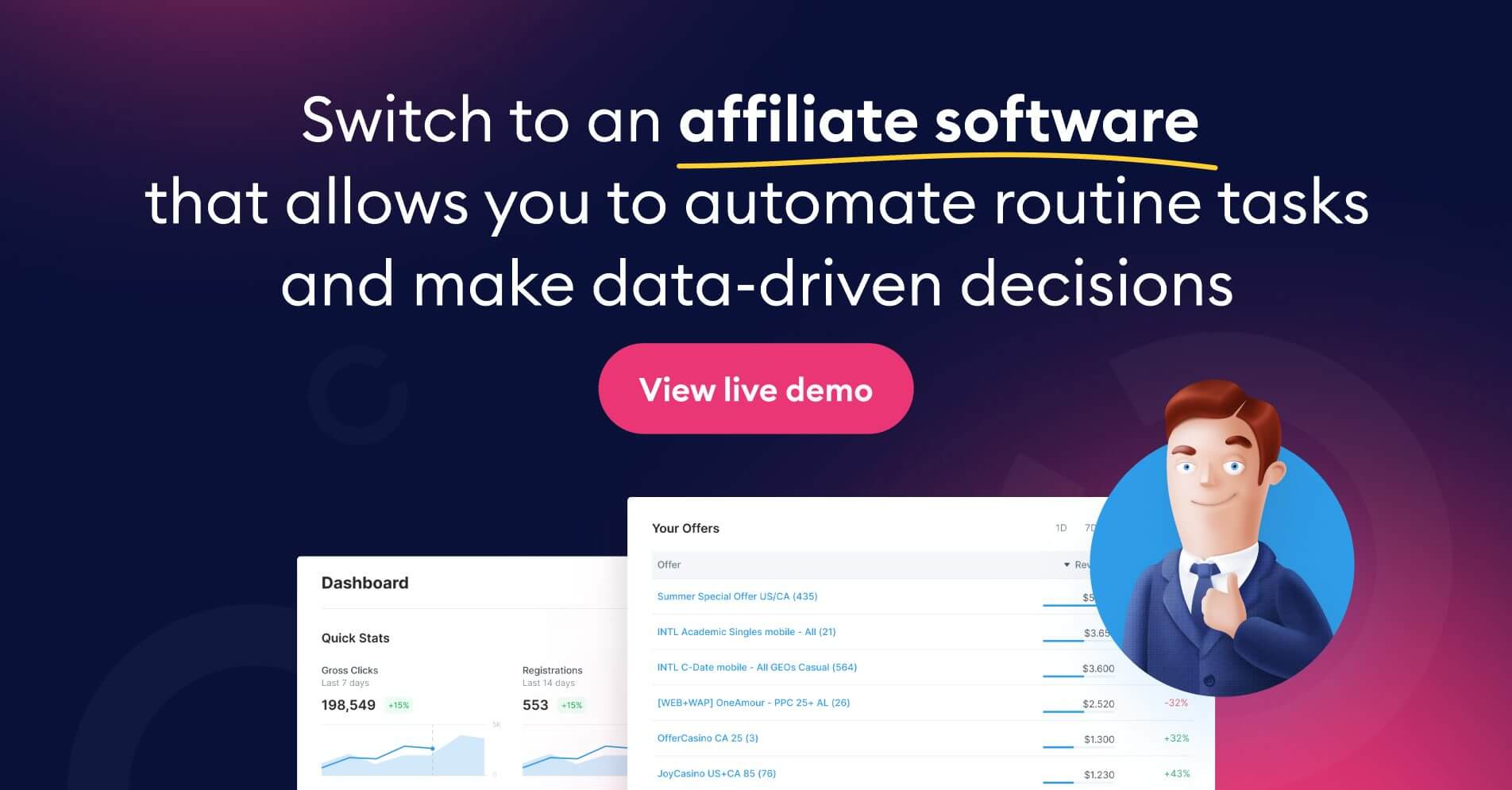Are you aiming to expand your B2B business? Using affiliate marketing to generate sales and revenue can be highly successful. In this comprehensive guide, we’ll offer a detailed introduction to B2B affiliate marketing, supplemented with success-oriented advice from industry leaders.
Regardless of your level of experience or knowledge of affiliate marketing, this guide aims to provide insightful information and practical advice to help you achieve your business objectives.
What Is a B2B Affiliate Marketing Program?
A B2B affiliate marketing program involves a company hiring affiliates to promote and sell its goods and services to other businesses. Each sale results in a commission paid to the affiliate.
There are several types of B2B affiliate programs, with the most common being the revenue-sharing model. In this model, businesses that generate affiliate sales are paid a commission. Other prevalent models include CPA (cost-per-action) and CPS (cost-per-sale).
B2B affiliate programs can be beneficial to businesses seeking to boost revenue and lead generation. Such programs incentivize companies to publicize a product or service, making them a potentially cost-effective marketing strategy.
B2C Affiliate Marketing Programs Vs. B2B Affiliate Marketing Programs
Although both B2C and B2B affiliate marketing programs fall under the umbrella of affiliate marketing, their target markets differ. B2C affiliate marketing programs aim to target consumers, whereas B2B affiliate marketing programs focus on corporations.
Adam Westreich, Founder of Westreich Consulting, states:
"One of the most notable distinctions between e-commerce and B2B is the revenue potential for affiliates, as B2B products typically sell for much more than, say, a pair of jeans. Investigating whether affiliate marketing is a realistic option for your B2B product is worthwhile."
How do I find B2B affiliate partners?
Here are some strategies you could use to find B2B, affiliate partners:
- Seek introductions from industry leaders or existing business contacts.
- Reach out to customer service representatives in your field of interest.
- Respond to comments on your blog and social media platforms.
- Connect with the affiliate partners of your competitors.
- Attend industry conferences and events.
- Contact your current customers who might be interested in partnerships.
- Include a link to your affiliate program in your website’s footer.
- Incorporate a link to your affiliate program in your customer emails.
- Mention your affiliate program link on purchase receipts.
- Run Google advertising targeted towards individuals looking to promote affiliate programs on their blogs.
- Leverage affiliate networks.
- Explore Google Affiliate advertising.
- Connect with content providers active on social media.
Does B2B affiliate marketing work?
Yes, B2B companies can run affiliate marketing initiatives. Affiliate marketing is a type of performance-based marketing that compensates one or more affiliates for each client acquired as a result of the affiliate’s own marketing efforts.
This type of marketing can help B2B companies reach new clients and expand their market. To ensure their affiliate marketing program is as successful as possible, B2B companies should carefully analyze their target market and the affiliates they want to collaborate with.
10 Prominent Examples of B2B Affiliate Marketing Programs:
- Monday.com Affiliate Program.
- Capsulink Affiliate Program.
- BigCommerce Affiliate Program.
- Shopify Affiliate Program.
- Webflow Affiliate Program.
- Look into the affiliate program.
- Square Affiliate Program.
- SEMrush Affiliate Program.
- Freshbooks Affiliate Program.
- Fiverr Affiliate Program.
Starting a B2B Affiliate Marketing Program:
Building a successful B2B affiliate marketing program requires hard work. However, with the right approach, you can develop a program that benefits your business. Here are 11 expert tips to get you started:
1. Don’t use affiliate marketing as your sole lead generation channel.
If you want to launch a successful B2B affiliate marketing program, you shouldn’t rely solely on affiliate marketing, especially if you’re a new creator in a B2B organization.
Instead, concentrate on establishing an effective overall marketing strategy that includes affiliate marketing as one component. This allows you to ensure the effectiveness of your affiliate marketing program and establish realistic channel KPIs for it.
2. Understand your role as an affiliate in the marketing funnel.
Before starting your affiliate program, understand how affiliates fit into your entire marketing funnel. It’s crucial to remember that affiliates are only one piece of the puzzle and should not be relied on to deliver all of your marketing results.
Affiliates in your organization may have the following roles:
- Prospecting for new clients
- Converting leads into paying customers
- Enhancing customer Retention and Loyalty
- Serving as brand ambassadors
Planning a product launch or a marketing campaign?
Utilize your affiliate partners as part of your distribution strategy: they will be able to amplify the push.
3. Set realistic channel KPIs.
When establishing an affiliate program, it is critical to establish realistic KPIs for the channel. Careful setting of realistic KPIs allows you to evaluate the early effectiveness of your affiliate marketing efforts and make any necessary changes to strategy and projections.
You may want to track the following business KPIs:
- Sales Generation
- Leads Generation
- Traffic Generation
- Conversion Rate
- Average Order Value
You may want to track the following affiliate-specific KPIs:
- Number of Accepted Affiliate Partners
- Index of Partner Activity
- Time Since the Last Partner Activity
- Earnings Per Click
4. Gradually construct a commission structure.
When designing a payment plan that will benefit both you and your affiliates, it is critical to take your time. This structure must be logical, competitive, and in line with your overall marketing goals.
Consider the type of products or services you offer, the average order value, and the margins you can afford. By taking the time to develop a robust commission structure, you will lay the groundwork for a profitable affiliate program.
Recommendation: Don’t set your program’s payout so high that it increases your customer acquisition cost (CAC). You don’t want to be in a position where you have to inform partners that your commission is being decreased.
5. Select the best affiliate network or program.
It is critical to choose the right affiliate network or program software. Not all affiliate programs and software are created equal. When launching your B2B affiliate marketing campaign, selecting the best affiliate network or software is essential.
This ensures you can access all the functionalities and resources needed to run a successful program.
Consider the following before selecting an affiliate network or software:
- Simpleness of use
- Pricing scheme: contracts might be monthly or annual.
- Track and report on affiliates
- Options for personalization
- Customer service and assistance
- Capabilities for affiliate recruitment
- Tracking of payouts
- Automated billing
Looking for the ultimate cloud-based white-label affiliate software to power your affiliate program? Try Scaleo!

It’s the leading B2B affiliate marketing software provider for companies of all sizes.
6. Plan the launch of your affiliate program.
Starting a successful affiliate program is a lot of work. It takes time, work, and planning, but with the right strategy and execution, it may be extremely beneficial to your firm.
Before you begin your affiliate marketing strategy, create a detailed launch plan. It will add to the success of your program by allowing affiliates to generate leads and revenue quickly.
Your affiliate program’s launch strategy should include the following elements:
- Creating advertising materials (for example, banners, emails, and blog entries)
- Making contact with affiliates and inviting them to join your program.
- Organizing a webinar or other forms of training to help affiliates become started
- Creating a system for tracking sales and leads.
- Make a paid media acquisition for publications that include affiliates.
- Using emails, create an affiliate onboarding nurturing program.
7. Set goals and challenges for affiliates.
Setting goals and challenges for affiliates is a great way to ensure your affiliate program’s success. This will keep them motivated and involved, ensuring they promote your goods or services as successfully as possible.
Here are some examples of difficulties and goals:
- Meeting a specific sales objective within a specific timeframe
- Creating a specified amount of leads in a given time frame
- Developing a set amount of social media posts or blog articles about your product or service
- Increasing the amount of traffic to your website
8. Make sure your affiliate terms and conditions are in order.
Before beginning a new affiliate program, having your terms and conditions in place is critical. By doing so, you can ensure that you and your affiliates are on the same page from afar and avoid any misunderstandings or legal issues.
Make sure to include:
- What you’re selling or advertising in terms of goods or services.
- What types of affiliates are you looking for? Blog writers, social media influencers, and so on.
- The manner by which commission is paid.
- Any restrictions on the affiliate’s ability to promote your goods or services in any location or manner.
- What happens if an affiliate violates your terms and conditions?
It is important to note that this is not legal advice. These are some suggestions for consideration while developing your terms and conditions. Always consult with a lawyer before publishing any type of legal documentation.
9. Create an onboarding and nurturing cycle for affiliates.
One of the keys to a successful affiliate program is ensuring that your affiliates are properly onboarded and nurtured from the start. This means providing them with all the information and resources they need to begin marketing your goods or services.
Using an affiliate onboarding nurturing cadence is a good way to accomplish this. Affiliates will receive regular updates on new deals, promotions, and other news and a step-by-step guide to getting started. If you take the time to onboard and assist your affiliates, they will successfully advertise your goods or services.
Here are a couple of email campaigns you should be running:
- Series of welcome emails
- Your first email lead/conversion
- 30-60-90 day check-in emails for your first sale
Always ensure that your added reward in the form of challenges is in line with your channel CAC targets!
10. Establish long-term relationships with key affiliates.
One of the most effective strategies to set your affiliate program for success is to cultivate strong relationships with your top affiliates. It offers you a group of ambassadors to help advertise your brand and guarantees that they are advertising your goods or services as effectively as possible. The best way to get your message out is to have your friends and family join you in the process.
There are a few things you can do to strengthen your relationships with your best affiliates, such as:
- Providing them with exclusive deals and promotions
- Recognizing their accomplishments in public
- Providing them the first access to new items or services
- Inviting them to events or gatherings
11. Make use of data and continue to optimize your approach.
Data is required for every efficient B2B affiliate marketing program. Use it to track the progress of your affiliates. Your program will be refined and updated on a regular basis, and you will know which marketing channels bring in the most clients and revenue.
It is vital to analyze this data regularly and use it to improve your approach. It could mean changing your salary structure or marketing strategy or testing a new creative idea. By employing data and replicating your strategy over and over, you may retain dynamic and lucrative affiliate network work.
Conclusion: B2B Affiliate Marketing Strategies.
As you can see, B2B affiliates can create commissions and improve income for both parties by cooperating with other companies and marketing their goods or services.
To succeed, you must carefully select your affiliate partners and regularly monitor and review the results of your affiliate marketing campaigns. Following the techniques outlined in this article and staying current on industry developments, businesses may successfully implement a B2B affiliate marketing strategy and get notable results.
Ready to get started with affiliate marketing?
Try Scaleo free for 14 days, no credit card required, and see how your business can benefit from a B2B affiliate program.

Last Updated on January 17, 2024






